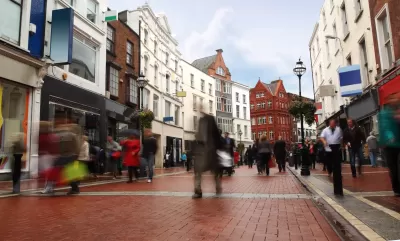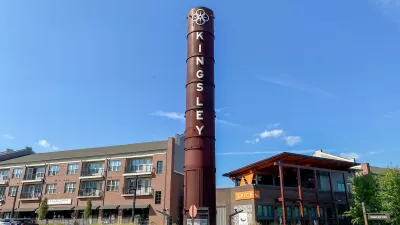Encouraging mixed-use neighborhoods that help reduce vehicle miles driven and put urban amenities within easy walking distance is possible with surprisingly modest policy tweaks.

Walkable neighborhoods and ’15-minute cities’ in the United States could be closer to reality than we might imagine, writes Kea Wilson in Streetsblog. This optimistic view comes in part from research showing that “U.S. homebuyers are hungry to live in neighborhoods where they don't always have to depend on cars to get around” and that, with some “modest policy changes,” U.S. cities could quickly become more pedestrian-friendly.
According to Wilson, “with a few inexpensive tweaks, millions of American neighborhoods may already be far closer to the 15-minute city ideal than policymakers realize.”
A study from Brookings Metro and Replica revealed that “even in the most car-dependent places in America, a lot of people actually do live near a lot of places they should theoretically be able to walk to — and even if those busy nodes aren't reachable on foot, those residents still traveled a shocking 14,500 fewer miles per year on average than their neighbors out in the sticks.” Wilson notes that the researchers defined “activity centers” more broadly, including “standalone mixed-use neighborhoods with a handful of cafes and churches but no bike lanes, or even arterial strip malls where no one would dare travel outside an automobile if given the choice.”
Adie Tomer, senior fellow at Brookings and the co-author of the report, advised that “to get average trip distances down even further, policymakers would be wise to, first, implement zoning reforms that allow Americans to build more activity centers in and around more census tracts, increase the housing supply in the destination-rich neighborhoods they've already got, and limit the construction of car-dependent new developments where there are few to no activity centers nearby.”
Tomer also advises transportation officials to “scrutinize the many reasons residents aren't choosing to visit their closest activity centers right now” and implement policies that support better access and more sustainable transportation modes.
FULL STORY: The Walkable Neighborhoods Americans Want May Be Closer Than We Think

Maui's Vacation Rental Debate Turns Ugly
Verbal attacks, misinformation campaigns and fistfights plague a high-stakes debate to convert thousands of vacation rentals into long-term housing.

Planetizen Federal Action Tracker
A weekly monitor of how Trump’s orders and actions are impacting planners and planning in America.

In Urban Planning, AI Prompting Could be the New Design Thinking
Creativity has long been key to great urban design. What if we see AI as our new creative partner?

Cal Fire Chatbot Fails to Answer Basic Questions
An AI chatbot designed to provide information about wildfires can’t answer questions about evacuation orders, among other problems.

What Happens if Trump Kills Section 8?
The Trump admin aims to slash federal rental aid by nearly half and shift distribution to states. Experts warn this could spike homelessness and destabilize communities nationwide.

Sean Duffy Targets Rainbow Crosswalks in Road Safety Efforts
Despite evidence that colorful crosswalks actually improve intersection safety — and the lack of almost any crosswalks at all on the nation’s most dangerous arterial roads — U.S. Transportation Secretary Duffy is calling on states to remove them.
Urban Design for Planners 1: Software Tools
This six-course series explores essential urban design concepts using open source software and equips planners with the tools they need to participate fully in the urban design process.
Planning for Universal Design
Learn the tools for implementing Universal Design in planning regulations.
Appalachian Highlands Housing Partners
Gallatin County Department of Planning & Community Development
Heyer Gruel & Associates PA
Mpact (founded as Rail~Volution)
City of Camden Redevelopment Agency
City of Astoria
City of Portland
City of Laramie





























